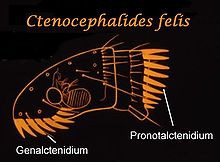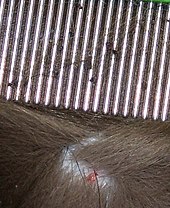Cat flea
| Cat flea | ||||||||||||
|---|---|---|---|---|---|---|---|---|---|---|---|---|

Cat flea ( Ctenocephalides felis ) |
||||||||||||
| Systematics | ||||||||||||
|
||||||||||||
| Scientific name | ||||||||||||
| Ctenocephalides felis | ||||||||||||
| Bouché , 1835 |
The cat flea ( Ctenocephalides felis ) is a parasitic wingless insect of the order of the fleas (Siphonaptera). Females are 2 to 3 mm long, males about 1 mm long and brown to red-brown in color. The cat flea is mainly found on infected animals and feeds on the host's blood , while its developmental stages are mainly found in hiding places. Due to its wide host range, the cat flea is a very common flea hard. It also affects humans and, among other things, plays a role as a disease vector.
morphology
Like all fleas, the cat flea is a wingless insect with three pairs of legs, the last of which has been transformed into strong jump legs , and a combined prick and proboscis as a mouth tool . It is brown to red-brown in color. Females are 2 to 3 mm long, males about 1 mm long.
The cat flea has an elongated head that is about twice as long as it is high. It can be distinguished from other types of flea by the spiked combs ( ctenidia ) made of chitin thorns . The head spiked comb ( Genalctenidium ) has seven to eight thorns, the first and second thorns being about the same length. The prothorax ( pronotalctenidium ) has about 16 thorns.
The edge of the talus on the dorsum of the foot has six notches from which bristles emerge.
Multiplication
Fertilized females lay around 30 eggs in the fur of infected animals 24 hours after mating. However, the approximately 0.5 mm large eggs soon fall off the animal and spread, mostly in the immediate vicinity of the sleeping places. After 4–5 days, the larva 1 hatches and feeds primarily on the digested blood of adult fleas and on organic material from the environment. Since the larvae are very sensitive to dehydration, they usually live hidden in grass, sand, carpeting and cracks. After molting to larvae 2 and 3, pupation takes place in a 5 mm cocoon .
In the pupal stage, the parasites are largely resistant to dehydration, light and most insecticides . The adult flea ( imago ) hatches through various stimuli such as heat, carbon dioxide content or vibrations. The entire development cycle takes about a month under favorable conditions, but can take several months if the ambient temperature is low.
Immediately after hatching, it looks for a new host by jumping. From this phase onwards, fleas usually live permanently on their hosts; if they are heavily infested, they also switch to other hosts passing by. The lifespan of the Imago is around one, in exceptional cases up to three months.
Only the adult fleas can survive the winter on their hosts and the pupae, but in heated rooms the development cycle can take place all year round.
Flea infestation
Due to its wide host range, the cat flea is one of the most widespread flea species. Despite the use of preventive flea products, estimates assume that up to 20% of dogs and cats have a flea infestation, with the maximum infestation occurring in late summer. In urban areas, the cat flea is the most common parasite in domestic dogs as well, the more specialized dog flea is more likely to be found in rural areas. Other animals and people are not spared from the cat flea either.
Fully grown (adult) fleas feed on their host's blood through their sucking-stinging mouthparts. You take in about 13 µl of blood per day. The flea excrement consists mainly of undigested blood components and is black and crumbly. If you put it on a moistened piece of paper, it turns reddish-brownish in color, which is an important proof of a low-grade infestation, since cats in particular are very effective at removing fleas, so that adult fleas may not be found on the host.

The flea bite creates a point-like reddening with a light halo, possibly a papule . If the infection is more severe, extensive skin inflammation ( dermatitis ) can develop. However, allergic reactions ( flea allergy ) are more frequent and clinically more noticeable and can lead to severe skin changes even if they are only slightly infected.
This flea also plays a role in indirect disease transmission because it is, for example, an important intermediate host for the cucumber seed tapeworm . Other pathogens such as mycoplasma (pathogen causing feline infectious anemia ), Bartonella henselae (pathogen causing cat scratch disease ) or Rickettsia felis are also spread by the cat flea.
Combat
Insecticides such as Afoxolaner , Fipronil , Imidacloprid , Metaflumizon , Nitenpyram , Selamectin , Fluralaner or Spinosad can be used against adult fleas . Chitin inhibitors such as Lufenuron are suitable for preventing larval development . Chlorpyrifos , permethrin , propoxur , fenoxycarb , pyrethrine , methoprene or combinations of these active ingredients are used for chemical environmental treatment . Permethrin is toxic to cats.
Piperonyl butoxide is a common synergist that inhibits the effects of insecticides such as B. Pyrethrins enhanced. However, it also "hinders the detoxification mechanism in the human body and therefore increases the risk of other insecticides".
If households with pets have fleas, the environment and the animals themselves should be treated at the same time. For the treatment of cats there are spot-ons and other medication against fleas, for the prevention of infestation / new infestation collars are suitable. Powders or sprays, on the other hand, are used to keep the environment - especially the sleeping area - free of pests.
Home remedies
The effects of home remedies are often not scientifically proven. They help best in combination and in some cases with individual adaptation using the trial-and-error method .
- Comb animals regularly with a flea comb, often dipping the comb in a bowl with water and a little washing-up liquid or soap.
- Vacuum carpets, beds and upholstered furniture every day. Put the bag in a plastic bag and throw it in the trash or store it in the freezer. As a preventive measure, you can put a drop of tea tree oil in the vacuum cleaner bag (attention, tea tree oil , like many essential oils, is toxic to cats.)
- Mop floors regularly.
- Wash everything washable, especially near the pets / bed baskets / sleeping places, as hot as possible and regularly.
- To set up a flea trap at night : fill a plate with soapy water and place a lit candle in the middle. (The fleas are attracted by the heat, light and CO 2 of the candle, fall into the water and drown because they cannot swim in soapy water.)
In order to interrupt the reproduction, both the home remedies, the veterinary treatment of all animals in the household and chemical control measures should be maintained for several weeks depending on the severity of the infestation, since flea eggs that are still present can produce new populations during this time.
literature
- Christian Epe, Monika Linek: Flea infestation and BAD in dogs and cats. In: The practical veterinarian. No. 88, 2007, Supplement 1, pp. 8-14.
- Ch. Noli and F. Scarampella: Practical dermatology in dogs and cats. 2nd unchanged edition, Schlütersche Verlagsanstalt, Hanover 2005, ISBN 3-87706-713-1 .
- Thomas Schnieder (Ed.): Veterinary Parasitology. 6th, completely revised and expanded edition, Parey, Stuttgart 2006, ISBN 3-8304-4135-5 .
- Anneliese Strenger : On the nutritional biology of the larvae of "Ctenocephalides felis". In: Zoological Yearbooks. Department of Systematics, Geography and Biology of Animals. (Zool. Jb. Syst.) Vol. 100, 1973, G. Fischer, Jena / Stuttgart u. a., ISSN 0044-5193 , pp. 64-80.
- Leaflet from the Pest Control Advice Center of the City of Zurich: Cat and dog fleas. PDF file, 103 kB .
Web links
Individual evidence
- ↑ Flea plague - health risk! On: merial.com ; last accessed on January 11, 2016.
- ↑ Unsuitable for velvet paws: Some tick remedies can poison cats . On: focus.de from June 6, 2012, last accessed on January 11, 2016.
- ↑ Pests in the house and garden: The great crawl . On: test.de from August 28, 2002, last accessed on January 11, 2016.
- ↑ LJ Fourie et al. a .: Control of immature stages of the flea Ctenocephalides felis (Bouche) in carpets exposed to cats treated with imidacloprid. In: Journal of the South African Veterinary Association. (JS Afr Vet Assoc.) December 2000, Volume 7, Number 4, pp. 219-221, PMID 11212931 .
- ↑ Test dog flea agent / cat flea agent. On: oekotest.de ( Öko-Test ) from June 2011; accessed on January 27, 2016.
- ↑ a b c Karin Born: Flea plague: fighting fleas in the apartment. Philosophy, July 10, 2012, retrieved January 26, 2016.
- ↑ Stefanie Vogt: What helps against fleas in dogs and cats? On haustiermagazin.com from July 2, 2015; accessed on January 26, 2016.
- ↑ Poisoning in cats. On: haustier-anzeiger.de / magazine. Edition 12/2006, accessed on January 11, 2016.
- ↑ Fighting cat fleas: home remedies. ( Memento of the original from January 27, 2016 in the Internet Archive ) Info: The archive link was inserted automatically and has not yet been checked. Please check the original and archive link according to the instructions and then remove this notice. On: hausgarten.net (Hausgarten Magazin) of October 30, 2011; accessed on January 26, 2016.


